话轮转换分析在《推销员之死》中的解释力
- 格式:doc
- 大小:37.00 KB
- 文档页数:9
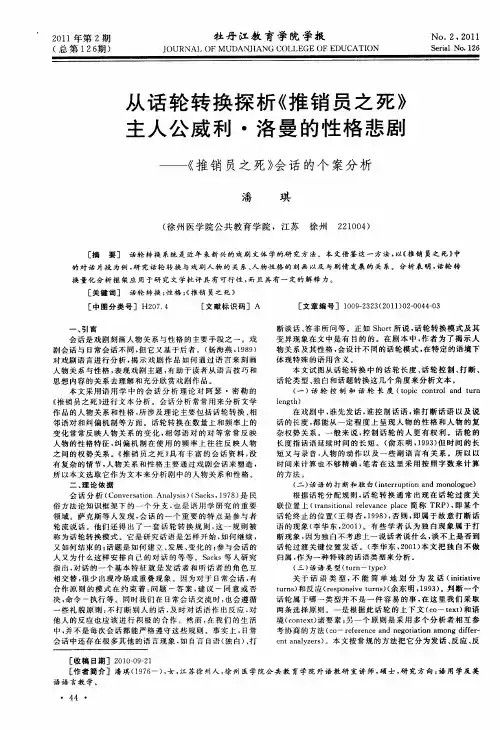
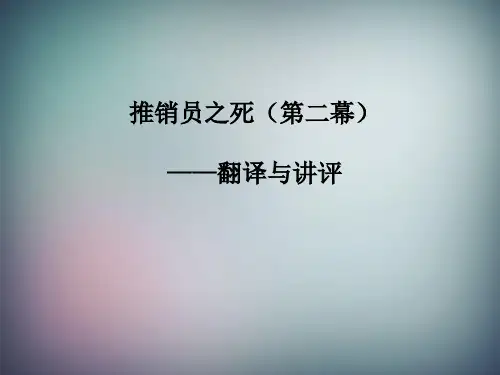
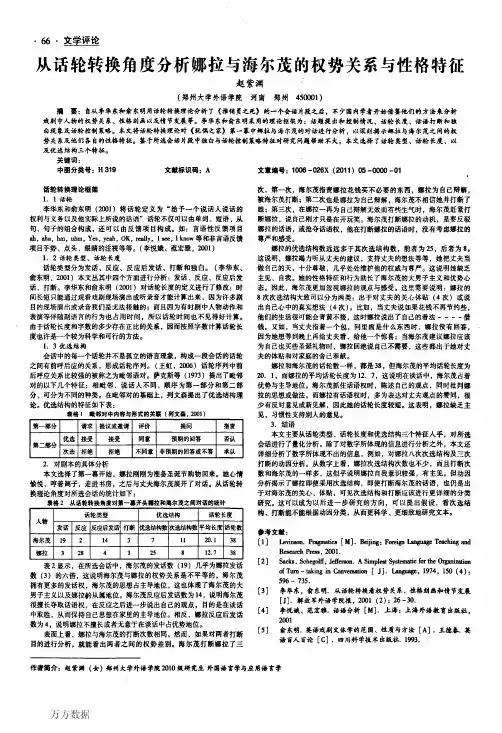
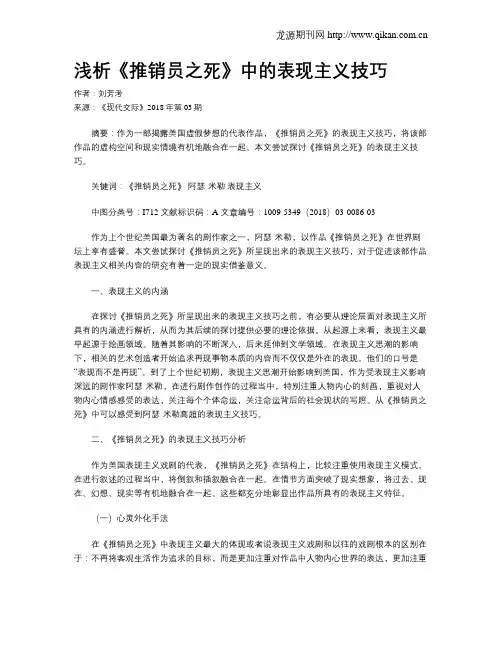
浅析《推销员之死》中的表现主义技巧作者:刘芳考来源:《现代交际》2018年第03期摘要:作为一部揭露美国虚假梦想的代表作品,《推销员之死》的表现主义技巧,将该部作品的虚构空间和现实情境有机地融合在一起。
本文尝试探讨《推销员之死》的表现主义技巧。
关键词:《推销员之死》阿瑟·米勒表现主义中图分类号:I712 文献标识码:A 文章编号:1009-5349(2018)03-0086-03作为上个世纪美国最为著名的剧作家之一,阿瑟·米勒,以作品《推销员之死》在世界剧坛上享有盛誉。
本文尝试探讨《推销员之死》所呈现出来的表现主义技巧,对于促进该部作品表现主义相关内容的研究有着一定的现实借鉴意义。
一、表现主义的内涵在探讨《推销员之死》所呈现出来的表现主义技巧之前,有必要从理论层面对表现主义所具有的内涵进行解析,从而为其后续的探讨提供必要的理论依据。
从起源上来看,表现主义最早起源于绘画领域。
随着其影响的不断深入,后来延伸到文学领域。
在表现主义思潮的影响下,相关的艺术创造者开始追求再现事物本质的内容而不仅仅是外在的表现。
他们的口号是“表现而不是再现”。
到了上个世纪初期,表现主义思潮开始影响到美国,作为受表现主义影响深远的剧作家阿瑟·米勒,在进行剧作创作的过程当中,特别注重人物内心的刻画,重视对人物内心情感感受的表达,关注每个个体命运,关注命运背后的社会现状的写照。
从《推销员之死》中可以感受到阿瑟·米勒高超的表现主义技巧。
二、《推销员之死》的表现主义技巧分析作为美国表现主义戏剧的代表,《推销员之死》在结构上,比较注重使用表现主义模式。
在进行叙述的过程当中,将倒叙和插叙融合在一起。
在情节方面突破了现实想象,将过去、现在、幻想、现实等有机地融合在一起。
这些都充分地彰显出作品所具有的表现主义特征。
(一)心灵外化手法在《推销员之死》中表现主义最大的体现或者说表现主义戏剧和以往的戏剧根本的区别在于:不再将客观生活作为追求的目标,而是更加注重对作品中人物内心世界的表达,更加注重对内在真实的呈现。
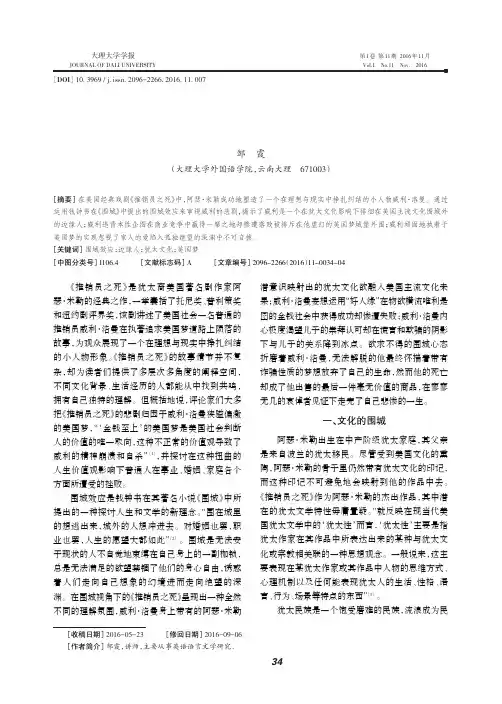
大理大学学报JOURNAL OF DALI UNIVERSITY 第1卷第11期2016年11月Vol.1No.11Nov.2016[DOI]10.3969/j.issn.2096-2266.2016.11.007《推销员之死》是犹太裔美国著名剧作家阿瑟·米勒的经典之作,一举囊括了托尼奖、普利策奖和纽约剧评界奖,该剧讲述了美国社会一名普通的推销员威利·洛曼在执著追求美国梦道路上陨落的故事,为观众展现了一个在理想与现实中挣扎纠结的小人物形象。
《推销员之死》的故事情节并不复杂,却为读者们提供了多层次多角度的阐释空间,不同文化背景、生活经历的人都能从中找到共鸣,拥有自己独特的理解。
但概括地说,评论家们大多把《推销员之死》的悲剧归因于威利·洛曼狭隘偏激的美国梦,“‘金钱至上’的美国梦是美国社会判断人的价值的唯一取向,这种不正常的价值观导致了威利的精神崩溃和自杀”〔1〕,并探讨在这种扭曲的人生价值观影响下普通人在事业、婚姻、家庭各个方面所遭受的挫败。
围城效应是钱钟书在其著名小说《围城》中所提出的一种探讨人生和文学的新理念。
“围在城里的想逃出来,城外的人想冲进去。
对婚姻也罢,职业也罢,人生的愿望大都如此”〔2〕。
围城是无法安于现状的人不自觉地束缚在自己身上的一副枷锁,总是无法满足的欲望禁锢了他们的身心自由,诱惑着人们走向自己想象的幻境进而走向绝望的深渊。
在围城视角下的《推销员之死》呈现出一种全然不同的理解氛围,威利·洛曼身上带有的阿瑟·米勒潜意识映射出的犹太文化欲融入美国主流文化未果;威利·洛曼妄想运用“好人缘”在物欲横流唯利是图的金钱社会中获得成功却惨遭失败;威利·洛曼内心极度渴望儿子的崇拜认可却在谎言和欺骗的阴影下与儿子的关系降到冰点。
欲求不得的围城心态折磨着威利·洛曼,无法解脱的他最终怀揣着带有诈骗性质的梦想放弃了自己的生命,然而他的死亡却成了他出售的最后一件毫无价值的商品,在寥寥无几的哀悼者见证下走完了自己悲惨的一生。
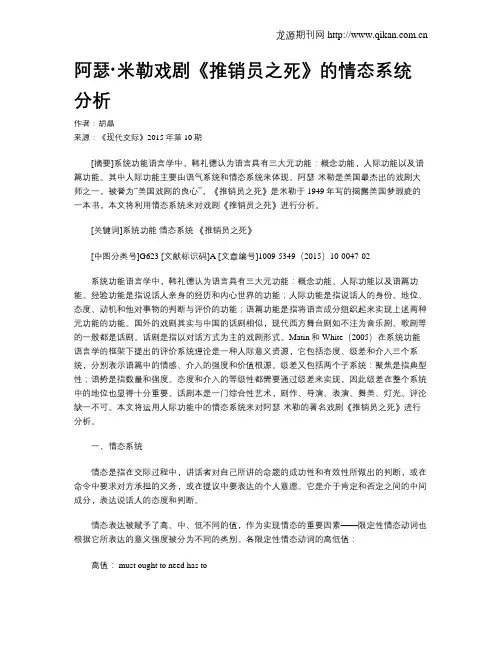
阿瑟·米勒戏剧《推销员之死》的情态系统分析作者:胡晶来源:《现代交际》2015年第10期[摘要]系统功能语言学中,韩礼德认为语言具有三大元功能:概念功能,人际功能以及语篇功能。
其中人际功能主要由语气系统和情态系统来体现。
阿瑟·米勒是美国最杰出的戏剧大师之一,被誉为“美国戏剧的良心”,《推销员之死》是米勒于1949年写的揭露美国梦瑕疵的一本书,本文将利用情态系统来对戏剧《推销员之死》进行分析。
[关键词]系统功能情态系统《推销员之死》[中图分类号]G623 [文献标识码]A [文章编号]1009-5349(2015)10-0047-02系统功能语言学中,韩礼德认为语言具有三大元功能:概念功能、人际功能以及语篇功能。
经验功能是指说话人亲身的经历和内心世界的功能;人际功能是指说话人的身份、地位、态度、动机和他对事物的判断与评价的功能;语篇功能是指将语言成分组织起来实现上述两种元功能的功能。
国外的戏剧其实与中国的话剧相似,现代西方舞台剧如不注为音乐剧、歌剧等的一般都是话剧。
话剧是指以对话方式为主的戏剧形式。
Matin和White(2005)在系统功能语言学的框架下提出的评价系统理论是一种人际意义资源,它包括态度、级差和介入三个系统,分别表示语篇中的情感、介入的强度和价值根源。
级差又包括两个子系统:聚焦是指典型性;语势是指数量和强度。
态度和介入的等级性都需要通过级差来实现,因此级差在整个系统中的地位也显得十分重要。
话剧本是一门综合性艺术,剧作、导演、表演、舞美、灯光、评论缺一不可。
本文将运用人际功能中的情态系统来对阿瑟·米勒的著名戏剧《推销员之死》进行分析。
一、情态系统情态是指在交际过程中,讲话者对自己所讲的命题的成功性和有效性所做出的判断,或在命令中要求对方承担的义务,或在提议中要表达的个人意愿。
它是介于肯定和否定之间的中间成分,表达说话人的态度和判断。
情态表达被赋予了高、中、低不同的值,作为实现情态的重要因素——限定性情态动词也根据它所表达的意义强度被分为不同的类别。
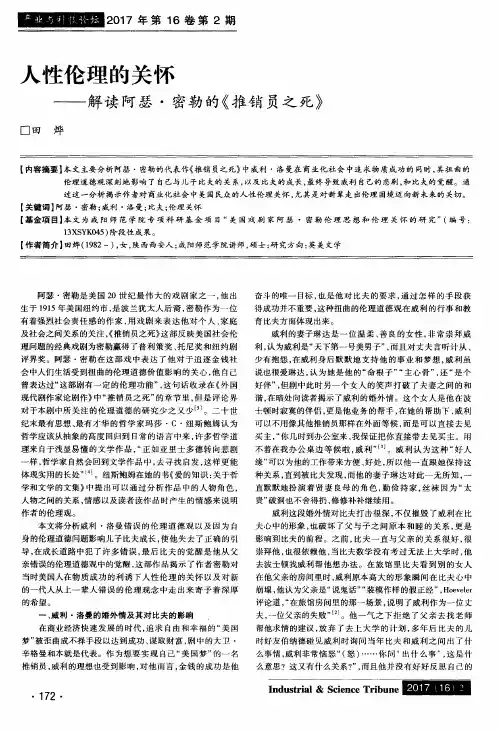
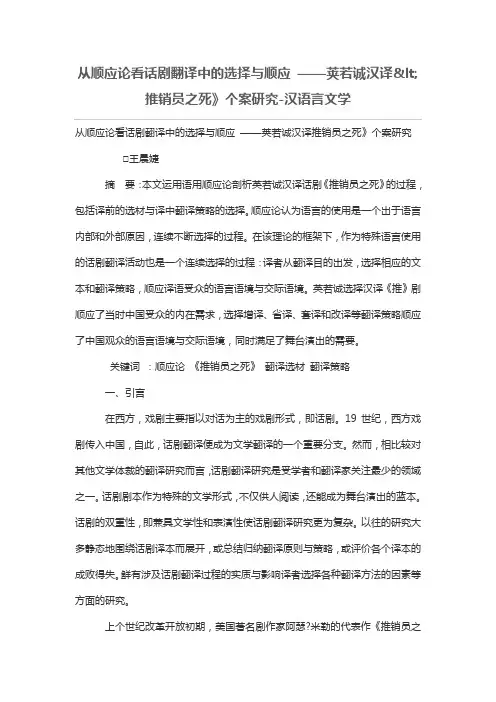
从顺应论看话剧翻译中的选择与顺应——荚若诚汉译<推销员之死》个案研究-汉语言文学从顺应论看话剧翻译中的选择与顺应——荚若诚汉译推销员之死》个案研究□王晨婕摘要:本文运用语用顺应论剖析英若诚汉译话剧《推销员之死》的过程,包括译前的选材与译中翻译策略的选择。
顺应论认为语言的使用是一个出于语言内部和外部原因,连续不断选择的过程。
在该理论的框架下,作为特殊语言使用的话剧翻译活动也是一个连续选择的过程:译者从翻译目的出发,选择相应的文本和翻译策略,顺应译语受众的语言语境与交际语境。
英若诚选择汉译《推》剧顺应了当时中国受众的内在需求,选择增译、省译、套译和改译等翻译策略顺应了中国观众的语言语境与交际语境,同时满足了舞台演出的需要。
关键词:顺应论《推销员之死》翻译选材翻译策略一、引言在西方,戏剧主要指以对话为主的戏剧形式,即话剧。
19世纪,西方戏剧传入中国,自此,话剧翻译便成为文学翻译的一个重要分支。
然而,相比较对其他文学体裁的翻译研究而言,话剧翻译研究是受学者和翻译家关注最少的领域之一。
话剧剧本作为特殊的文学形式,不仅供人阅读,还能成为舞台演出的蓝本。
话剧的双重性,即兼具文学性和表演性使话剧翻译研究更为复杂。
以往的研究大多静态地围绕话剧译本而展开,或总结归纳翻译原则与策略,或评价各个译本的成败得失。
鲜有涉及话剧翻译过程的实质与影响译者选择各种翻译方法的因素等方面的研究。
上个世纪改革开放初期,美国著名剧作家阿瑟?米勒的代表作《推销员之死》由著名话剧翻译大师英若诚翻译,并被搬上了中国舞台,演出获得巨大反响,中外观众交口称赞。
该剧在中国的成功上演,离不开剧作家、演职人员的通力合作,英先生对剧本的成功翻译更是不可或缺。
学界曾这样评价其译文:在忠于原作的基础上中国化、巧妙地使用北京方言,拉近与观众的距离。
[1]本文试图运用语用顺应论探讨英若诚选择翻译《推销员之死》并灵活采用各种翻译方法的原因,动态描述话剧翻译的过程,解释译者在翻译过程中的各种选择与顺应的层面。
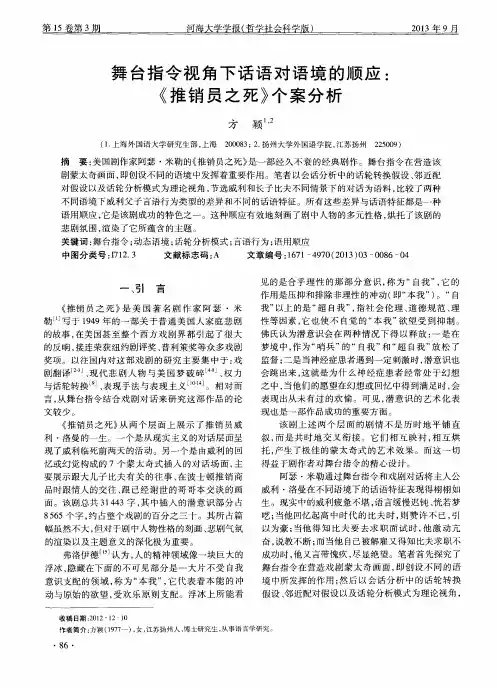
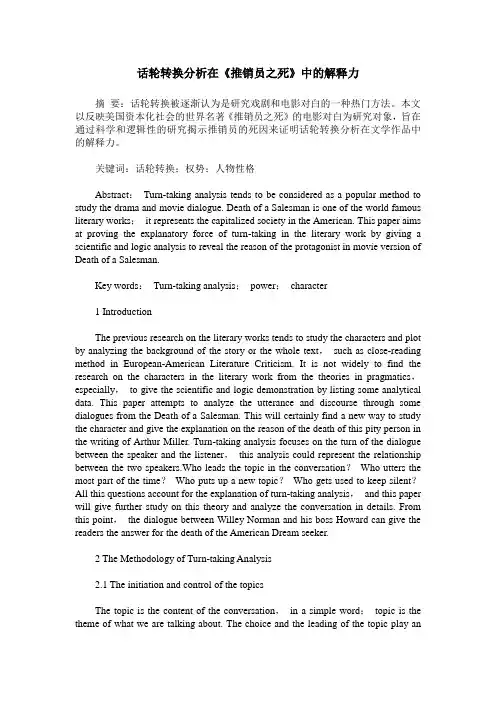
话轮转换分析在《推销员之死》中的解释力摘要:话轮转换被逐渐认为是研究戏剧和电影对白的一种热门方法。
本文以反映美国资本化社会的世界名著《推销员之死》的电影对白为研究对象,旨在通过科学和逻辑性的研究揭示推销员的死因来证明话轮转换分析在文学作品中的解释力。
关键词:话轮转换;权势;人物性格Abstract:Turn-taking analysis tends to be considered as a popular method to study the drama and movie dialogue. Death of a Salesman is one of the world famous literary works;it represents the capitalized society in the American. This paper aims at proving the explanatory force of turn-taking in the literary work by giving a scientific and logic analysis to reveal the reason of the protagonist in movie version of Death of a Salesman.Key words:Turn-taking analysis;power;character1 IntroductionThe previous research on the literary works tends to study the characters and plot by analyzing the background of the story or the whole text,such as close-reading method in European-American Literature Criticism. It is not widely to find the research on the characters in the literary work from the theories in pragmatics,especially,to give the scientific and logic demonstration by listing some analytical data. This paper attempts to analyze the utterance and discourse through some dialogues from the Death of a Salesman. This will certainly find a new way to study the character and give the explanation on the reason of the death of this pity person in the writing of Arthur Miller. Turn-taking analysis focuses on the turn of the dialogue between the speaker and the listener,this analysis could represent the relationship between the two speakers.Who leads the topic in the conversation?Who utters the most part of the time?Who puts up a new topic?Who gets used to keep silent?All this questions account for the explanation of turn-taking analysis,and this paper will give further study on this theory and analyze the conversation in details. From this point,the dialogue between Willey Norman and his boss Howard can give the readers the answer for the death of the American Dream seeker.2 The Methodology of Turn-taking Analysis2.1 The initiation and control of the topicsThe topic is the content of the conversation,in a simple word;topic is the theme of what we are talking about. The choice and the leading of the topic play animportant role in the development of the whole conversation. If the speaker intends to join the topic,he or she will adopt certain conversational strategies to show his interests on it,the opposite situation is the same,if the speaker is unwilling to continue the conversation,he or she will not initiate the topic actively. The person who is in the higher position tends to get more chance and right to initiate the topic,even to control it.2.2 Turn lengthSome scholars hold that the turn length shall be the extension time of the conversation,however,it is too hard to count accurately how much time a given conversation costs. Time-counting method is lacking of the scientific support. The popular method to measure the length of the turn in the dialogue is to count the number of the word uttered by the speakers. As exemplified,here is a conversation between a strict mother and her son:Mother:Have you finish your homework?Son:No.It is obvious to give the conclusion that the mother has the absolute power from this conversation,because the number of the word of the mother sums up to 11,however,her son only give a one-word reply “No”.2.3 Turn-typeIn Sack’s opinion,the turn-type can be divided into the initiative turns and the responsive turns. However,for the complex situation in the real life,there are so many examples to violate this division. Since sometimes after the speaker gives an utterance,another participant tends to keep silent or talk the things having nothing to the topic of the speaker instead of following some conversational principles. This kind of situation can not be concluded as the initiative turn or the responsive turns. (Li ying 2006:79)2.4 Interruption and monologueFrom the above statement,the interruption and monologue can be considered as the special division of the turn-type. In a given conversation,one initiates a topic,for the reason of unwilling to cooperate with the initiative speaker,another one will interrupt the topic to suddenly change the topic or to speak no word or to talk anything he or she wants but not related to the whole topic. These kinds of situations can be noted as the interruption and monologue. In the literature work,especially,the drama includes a lot of intentional interruption and monologue to display the dramatic effect. This will be proved in the following analysis in details.2.5Turn-control strategiesAccording to the turn allocation rule of Sacks,the participant in the conversation will adopt certain strategies to control the topic or choose someone to speak. In this paper,we hold that there are two types of the turn-control strategies:initiation of the next turn and termination of the turn.3 Analysis on the conversationDeath of a Salesman is the work of a famous American writer Auther Miller. It tells a story that a traveling service salesman tries his best effort to fulfill his American Dream,but fails at last. The salesman experiences every kinds of the unfair treatment in the cruelly real life. This paper will analyze the dialogue between the protagonist Willey and his boss Howard to find the reason causing the death of the salesman. However,the purpose is not only to analyze the reason but also to apply the above the theories.This part of the dialogue happens in the background that Willey wants to ask for a job in the office from his boss,however,he is refused by Howard. This the critical reason of the protagonist who was full of ambition and dreams steps into the desperation leading to his death. How does the conversation play such a strong effect on the heart of him?How does Howard push the poor man to the fire by using the power to disdain the self-esteem of the salesman?There are 66 turns in the conversation between Willey and Howard,among the total number of the turns,Willey accounts for 33 turns and Howard also accounts for 33.Willy says:“Like to have a little talk with you,Howard”,however,his boss Howard just plays his radio but not gives the direct reply for his topic. The following dialogue excerpted from the movie script of the Death of a Salesman.Willy:I m definitely going to get one (the wire recorder).Because lots of time I’m on the road,and I think to myself,what I must be missing on the radio!Howard:Don’t you have a radio in the car?Willy:Well,yeah,but who ever think of turning it on?Howard:Say,aren’t you supposed to be in Boston?Willy:That s what I want to talk to you about,Howard. You got a minute?Howard:What happened?What are you doing here?(Li donghua 2001:30)Willey initiate the topic of changing the job from the car to the office,but Willy uses 3 turns in talking about the radio among the whole 4 turns. This can be considered as a kind of turn-taking strategies:using the limitation of the next turn torestrict the topic not to change to the job.Willey tried to interrupt this topic to express his intention for 4 times,which has been all turned a deaf ear by Howard. Howard was always talking about the matter of radio like no ones watching. Unexpectedly,this topic is irrelevant to subject brought more than 40 turns. After a long time of talking about the radio he finally awakened as if he were just from a dream to pay attention to Willey Howard and asked:“Say,aren’t’t you supposed to be in Boston?” ,and then 3 more questions consecutively were asked without leaving time for Willey’s answer which stressed Howard’s arrogant attitude.ConclusionTurn-taking occurs in every kinds of conversation,the methodology of turn-taking analysis create a novel way to study certain literature work through the conversation analysis.This present paper not only briefly explains the theory framework of the turn-taking analysis,but also applies this method in analyzing the characters in the movie script of the Death of a Salesman. From the study of the conversation,we find the relationship between the protagonists,especially,the power relation. This quantitative analysis represents how the cold-blood boss Howard turns a blind eye to the difficulty of Willey. His indifference and his arrogant attitude are all the reason that leads to the death of the salesman. The analysis gives us the clear explanation of the reason through the conversation between them. The turn-taking analysis creates the scientific way of doing the literary study,which is the most critical purpose of this paper.Reference:[1]姜望琪.《语用学理论及应用》[M].北京:北京大学出版社,2000[2]刘世生,朱瑞青.《文体学概论》[M].北京:北京大学出版社,2006[3]杨雪燕.话语分析与戏剧语言文体学[J].外语教学与研究,1991 (2):45-48.[4]李颖.从戏剧中的话轮转换看人物性格和人物关系[J].安徽工业大学学报,2006(3):79-82.[5]李东华.从话轮转换看权势关系[J].解放军外国语学院学报,2001,(2):26-30.。
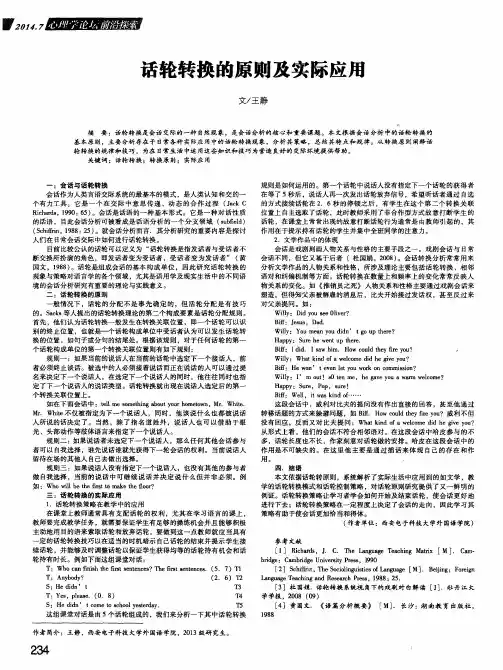
INTRODUCTION OF THE AUTHORArthur Miller (17 Oct 1915 – 2005) was one of the leadingAmerican playwrights of the twentieth century. He was bornin New York on October 17, 1915, the son of Polish-Jewishimmigrants. His father manufactured women’s coats, b ut losteverything in the economic collapse of the 1930s. Aftergraduating from high school, Miller worked in a warehouseso that he could earn enough money to attend the Universityof Michigan. During his college years, he began writing hisfirst drama.Miller's first play to make it to Broadway, The Man Who Had All the Luck (1944), was a dismal failure, closing after only four performances. This early setback almost discouraged Miller from writing completely, but, fortunately, he gave himself one more try. Three years later, All My Sons won the New York Drama Critics' Circle Award as the best play of 1947, launching Miller into theatrical stardom. His most impressive play is Death of a Salesman(1949, Pulitzer Prize), fusing realism and symbolism in reviewing the tragic life of a salesman victimized by his own false values and those of modern America.Miller was a prominent figure in American theatre and cinema for almost 100 years, writing a wide variety of dramas, including celebrated plays such as The Crucible, A View from the Bridge, All My Sons, and Death of a Salesman, which are studied and performed worldwide. Miller is considered by audiences and scholars as one of America's greatest playwrights and his plays are lauded throughout the world.Notice the sub-title of the play: Certain Private Conversations in Two Acts and a Requiem.两幕私下的谈话及一首安魂曲Many things in this play happen in Loman’s head.[2] Main characters 剧中人物:Willy Loman 威利·洛曼Linda Loman 琳达·洛曼—威利·洛曼的妻子[3] The action takes place in WILLY LOMAN’s house and yard and in various places he visits in the New York and Boston of today.本剧发生于威利·洛曼家中的室内和庭院中,以及他去纽约和波士顿的几个地方。
从话轮转换角度看人物权势关系和性格刻画—以《推销员之死》某一话语片段为例摘要:在戏剧文本中运用话轮转换模式能够帮助我们从语言学角度对戏剧人物的表现作出阐释,并且使得对戏剧人物的评论建立在相对客观的基础上。
本文在简要介绍戏剧文体学话语分析模式的基础上,着重从该模式的五个层面对《推销员之死》中的对话片断的三个子话题进行了细致分析,解读出作品中上级与下级之间、贫穷与富贵之间的权势关系以及威利的理想主义和霍华德冷酷无情的人物性格。
实例分析表明,通过话轮分析能更好地了解人物性格和权势关系,提供一个恰当的视角来欣赏戏剧,理解和欣赏经典作品。
关键词:话轮转换分析,权势关系,人物性格,戏剧文体学1.引言美国社会学家萨克斯(Sacks)、谢格洛夫(Schegloff)和杰弗逊(Jefferson)于1974年系统地提出了话轮转换理论(Turn-Taking Model),随后国内外相关领域的研究成果大大促进了戏剧文体学的蓬勃发展(Sacks,Schegloff & Jefferson, 1974)。
戏剧文体学的突破在于将语用学与话语分析这两个既有联系又有区别的研究领域有机结合起来,将其理论应用于戏剧批评,涉及到的范畴包括言语行为、合作原则、礼貌原则、语域分析和话轮转换等(Short, 1898;杨雪燕,1989, 1991;俞东明,1993,1996)。
而戏剧区别于小说、诗歌的一个主要特征就是它强调对话关系,也就是说戏剧是通过对话反映人与人之间关系及相互作用(Thornborrow & Wareing, 2000),而且人们在话轮转换方面的选择可以反映会话参与者的身份、地位及相互关系(Pomerantz & Fehr, 1997),因而话轮转换理论可以用于解释人物之间的权势关系及人物性格,从而推动剧情的发展。
因此,本文从话轮转换角度入手,采用李华东和俞东明的话轮分析框架,以阿瑟·米勒的《推销员之死》中的剧本第二幕为例,也就是威利去找他的老板霍华德,请求他允许自己做些办公室工作,却被霍华德解雇的片段。
作者简介:阿瑟·密勒(1915—)美国剧作家。
出生在纽约一个富裕的制造商家庭,父亲在大萧条时期破产。
密勒1932年中学毕业后就外出谋生,在汽车零件仓库干过活。
1934年入密执安大学,开始戏剧创作,并得过戏剧协会的奖。
1944 年,他的《鸿运高照的人》在百老汇上演,未获成功。
他的成名作是1947年上演的《全是我的儿子》获纽约剧评奖。
此剧讲一个不负责任的制造商把不及格的飞机零件卖给空军,导至飞机失事,21名飞行员(包括他的幼子)死亡,别人因此坐牢,他却逃过了法律制裁。
后来,他的儿子提出要娶弟弟的未婚妻,那个为他父亲坐了牢的人的女儿,终于使他受到良心谴责,认识到那些丧命的飞行员“全是我的儿子”,于是自杀。
1949年上演的《推销员之死》是密勒的杰作,获纽约剧评奖和普列策奖。
1953年上演的历史剧《炼狱》,影射当时麦卡锡主义对左翼人士的迫害。
密勒本人在1950年曾受非美活动委员会传讯并被判藐视国会罪。
1958 年才由最高法院撤销这一罪名。
他的其他剧作有《两个星期一的回忆》,反映他本人早期在汽车零件仓库工作的一些经历;《桥头眺望》反映意大利非法移民在美国的悲惨遭遇。
密勒曾和好莱坞红星玛丽莲·梦露结婚,为她写过电影剧本《不合时宜的人》,1961年密勒和梦露离婚后,再娶奥地利籍摄影师英吉保丽·莫拉斯,这段经历反映在剧作《堕落以后》中。
另外,他还写了《维希事件》和《代价》、《美国时钟》及大量戏剧评论。
密勒最爱写人的负罪感和良心发现。
他一贯反对纯娱乐性的庸俗戏剧,提倡严肃戏剧。
内容概要:威利·洛曼是个巡回推销员,他一直相信讨人喜欢和坚持是事业和主活成功的关键。
他的偶像是推销员大卫·辛格曼。
他活到84岁,只要在旅馆里拨个电话,就能做成交易,死后在新英格兰有许多买主和同行为他送葬,极尽哀荣。
现在威利已63岁了,干推销这一行已经34年。
早年曾为老板在新英格兰开创地盘立过汗马功劳,可是如今年老力衰,货物又推销不出去,也就赚不到佣金,而家里的种种费用却要如期支付,如房屋分期付款,保险费等等。
从人际功能的角度研究阿瑟米勒的戏剧《推销员之死》从人际功能的角度研究阿瑟米勒的戏剧《推销员之死》摘要:本文采用人际功能理论对阿瑟米勒的戏剧《推销员之死》进行了深入研究。
文章首先介绍了人际功能理论的基本概念和内涵,在此基础上,结合剧作的情节、人物及其关系等方面,对该剧进行了分析,探讨了其所反映的社会现象和价值观念,并阐明了其对于社会的现实意义和启示。
本文认为,《推销员之死》既是一部现实主义剧作,也是一部具有深刻人性洞见的文学作品。
它通过对人际关系的描绘和分析,反映了人类社会中存在的各种问题和现象,同时也启示了我们如何在当下社会中理解和应对这些问题。
关键词:人际功能理论;阿瑟米勒;《推销员之死》一、人际功能理论的基本概念人际功能理论是由美国心理学家福尔姆(George Herbert Mead)提出的一种社会认知理论,其核心是关注个体如何在社会交往中根据其他人的期望和信号而形成自我意识和自我概念。
具体来说,人际功能理论主要包括以下三个方面:1.人际角色——个体在交往中所扮演的角色和相应的期望。
2.社会化——个体通过与他人交流和互动,从而获得社会规范、价值观念和文化认同等方面的社会化。
3.社会自我——个体在交往中表现出来的自我意识和角色意识,以及这些意识的在社会上的认同和接受。
二、《推销员之死》的分析《推销员之死》是阿瑟米勒于1949年创作的一部戏剧作品。
剧作主要讲述了一个推销员威利·罗曼在商场失意之后走向自杀的故事。
通过对威利的描写和剖析,该剧反映了人们在资本主义社会中所面临的各种压力和矛盾,并质疑了商业价值观在当代社会中的合理性。
在该剧中,人物的人际角色起到了重要的推动作用。
威利作为一个推销员,一直在追求事业上的成功和财富的积累。
然而,由于道德沦丧、利益冲突等原因,他的事业陷入了瓶颈期,他自身的社会价值感也受到了严重的挑战。
在这种情况下,威利的精神状态开始逐渐崩溃,他开始出现幻觉、妄想等问题,并最终选择了自杀。
话轮转换分析在《推销员之死》中的解释力摘要:话轮转换被逐渐认为是研究戏剧和电影对白的一种热门方法。
本文以反映美国资本化社会的世界名著《推销员之死》的电影对白为研究对象,旨在通过科学和逻辑性的研究揭示推销员的死因来证明话轮转换分析在文学作品中的解释力。
关键词:话轮转换;权势;人物性格abstract: turn-taking analysis tends to be considered as a popular method to study the drama and movie dialogue. death of a salesman is one of the world famous literary works; it represents the capitalized society in the american. this paper aims at proving the explanatory force of turn-taking in the literary work by giving a scientific and logic analysis to reveal the reason of the protagonist in movie version of death of a salesman.key words: turn-taking analysis; power; character1 introductionthe previous research on the literary works tends to study the characters and plot by analyzing the background of the story or the whole text, such as close-reading method in european-american literature criticism. it is not widely to find the research on the characters in the literary work from the theories in pragmatics, especially, to give thescientific and logic demonstration by listing some analytical data. this paper attempts to analyze the utterance and discourse through some dialogues from the death of a salesman. this will certainly find a new way to study the character and give the explanation on the reason of the death of this pity person in the writing of arthur miller. turn-taking analysis focuses on the turn of the dialogue between the speaker and the listener, this analysis could represent the relationship between the two speakers.who leads the topic in the conversation? who utters the most part of the time? who puts up a new topic? who gets used to keep silent? all this questions account for the explanation of turn-taking analysis, and this paper will give further study on this theory and analyze the conversation in details. from this point, the dialogue between willey norman and his boss howard can give the readers the answer for the death of the american dream seeker.2 the methodology of turn-taking analysis2.1 the initiation and control of the topicsthe topic is the content of the conversation, in a simple word; topic is the theme of what we are talking about. the choice and the leading of the topic play an important rolein the development of the whole conversation. if the speaker intends to join the topic, he or she will adopt certain conversational strategies to show his interests on it, the opposite situation is the same, if the speaker is unwilling to continue the conversation, he or she will not initiate the topic actively. the person who is in the higher position tends to get more chance and right to initiate the topic,even to control it.2.2 turn lengthsome scholars hold that the turn length shall be the extension time of the conversation, however, it is too hard to count accurately how much time a given conversation costs. time-counting method is lacking of the scientific support. the popular method to measure the length of the turn in the dialogue is to count the number of the word uttered by the speakers. as exemplified, here is a conversation between a strict mother and her son:mother: have you finish your homework?son: no.it is obvious to give the conclusion that the mother has the absolute power from this conversation, because the number of the word of the mother sums up to 11, however, her sononly give a one-word reply “no”.2.3 turn-typein sack’s opinion, the turn-type can be divided into the initiative turns and the responsive turns. however, for the complex situation in the real life, there are so many examples to violate this division. since sometimes after the speaker gives an utterance, another participant tends to keep silent or talk the things having nothing to the topic of the speaker instead of following some conversational principles. this kind of situation can not be concluded as the initiative turn or the responsive turns. (li ying 2006:79)2.4 interruption and monologuefrom the above statement, the interruption and monologue can be considered as the special division of the turn-type. in a given conversation, one initiates a topic, for the reason of unwilling to cooperate with the initiative speaker,another one will interrupt the topic to suddenly change the topic or to speak no word or to talk anything he or she wants but not related to the whole topic. these kinds of situations can be noted as the interruption and monologue. in the literature work, especially, the drama includes a lot of intentional interruption and monologue to display thedramatic effect. this will be proved in the following analysis in details.2.5turn-control strategiesaccording to the turn allocation rule of sacks, the participant in the conversation will adopt certain strategies to control the topic or choose someone to speak. in this paper,we hold that there are two types of the turn-control strategies: initiation of the next turn and termination of the turn.3 analysis on the conversationdeath of a salesman is the work of a famous american writer auther miller. it tells a story that a traveling service salesman tries his best effort to fulfill his american dream,but fails at last. the salesman experiences every kinds of the unfair treatment in the cruelly real life. this paper will analyze the dialogue between the protagonist willey and his boss howard to find the reason causing the death of the salesman. however, the purpose is not only to analyze the reason but also to apply the above the theories.this part of the dialogue happens in the background that willey wants to ask for a job in the office from his boss,however, he is refused by howard. this the critical reasonof the protagonist who was full of ambition and dreams steps into the desperation leading to his death. how does the conversation play such a strong effect on the heart of him?how does howard push the poor man to the fire by using the power to disdain the self-esteem of the salesman? there are 66 turns in the conversation between willey and howard, among the total number of the turns, willey accounts for 33 turns and howard also accounts for 33.willy says:“like to have a little talk with you, howard”,however, his boss howard just plays his radio but not gives the direct reply for his topic. the following dialogue excerpted from the movie script of the death of a salesman.willy: i m definitely going to get one (the wire recorder) .because lots of time i’ m on the road, and i think to myself, what i must be missing on the radio!howard: don’t you have a radio in the car?willy: well, yeah, but who ever think of turning it on?howard: say, aren’t you supposed to be in boston?willy: that s what i want to talk to you about, howard. you got a minute?howard: what happened? what are you doing here?(li donghua 2001:30)willey initiate the topic of changing the job from the car to the office, but willy uses 3 turns in talking about the radio among the whole 4 turns. this can be considered as a kind of turn-taking strategies: using the limitation of the next turn to restrict the topic not to change to the job.willey tried to interrupt this topic to express his intention for 4 times, which has been all turned a deaf ear by howard. howard was always talking about the matter of radio like no ones watching. unexpectedly, this topic is irrelevant to subject brought more than 40 turns. after a long time of talking about the radio he finally awakened as if he were just from a dream to pay attention to willey howard and asked:“say, aren’t’ t you supposed to be in boston?”, and then 3 more questions consecutively were asked without leaving time for willey’s answer which stressed howard’s arrogant attitude.conclusionturn-taking occurs in every kinds of conversation, the methodology of turn-taking analysis create a novel way to study certain literature work through the conversation analysis.this present paper not only briefly explains the theoryframework of the turn-taking analysis, but also applies this method in analyzing the characters in the movie script of the death of a salesman. from the study of the conversation, we find the relationship between the protagonists, especially,the power relation. this quantitative analysis represents how the cold-blood boss howard turns a blind eye to the difficulty of willey. his indifference and his arrogant attitude are all the reason that leads to the death of the salesman. the analysis gives us the clear explanation of the reason through the conversation between them. the turn-taking analysis creates the scientific way of doing the literary study, which is the most critical purpose of this paper.reference:[1]姜望琪.《语用学理论及应用》[m].北京:北京大学出版社,2000[2]刘世生,朱瑞青.《文体学概论》[m].北京:北京大学出版社,2006[3]杨雪燕.话语分析与戏剧语言文体学[j].外语教学与研究,1991 (2):45-48.[4]李颖.从戏剧中的话轮转换看人物性格和人物关系[j].安徽工业大学学报,2006(3):79-82.[5]李东华.从话轮转换看权势关系[j].解放军外国语学院学报,2001,(2):26-30.。